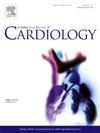非糖尿病超重和肥胖个体的亚临床心肌功能损害:心脏代谢特征的影响
IF 3.2
2区 医学
Q2 CARDIAC & CARDIOVASCULAR SYSTEMS
引用次数: 0
摘要
背景:在超重和肥胖人群中检测心脏损害对于早期预防心力衰竭至关重要。心肌功是一种新的超声心动图参数,它将左心室后负荷纳入全局纵向应变分析。本研究旨在:1)评估左心室射血分数(LVEF)正常的非糖尿病超重和肥胖个体心肌功的亚临床改变;2)研究心脏代谢特征对这些改变的影响;3)确定心肌功与心肌组织特性的相关性。方法在前瞻性早期myo - obesity - ii研究(NCT 04933188)中,我们招募了150名非糖尿病参与者,其中包括50名肥胖个体(BMI≥30 kg/m2), 50名年龄和性别匹配的超重个体(BMI 25-30 kg/m2)和50名健康瘦对照(BMI <;25 kg / m2)。通过二维斑点跟踪超声心动图和袖带血压计算无创心肌功,通过细胞外体积分数(ECV)和心脏磁共振成像的原生T1值评估心肌纤维化。结果肥胖组整体工作指数(GWI)和建设性工作指数(GCW)均低于超重组和对照组。超重和肥胖组均表现出全球浪费工作(GWW)的增加和全球工作效率(GWE)的降低。在多元回归分析中,胰岛素抵抗稳态模型评估(HOMA-IR)值升高与GWI和GCW降低独立相关(β分别= - 89.953和- 121.191)。与对照组相比,超重和肥胖组的ECV和原生T1升高。GWW和GWE与ECV显著相关(Spearman’s Rho分别为0.516和- 0.547),与总体纵向应变(AUC = 0.58)相比,对心肌纤维化的预测价值更高(AUC分别为0.86和0.82)。结论非糖尿病超重和肥胖者即使保留LVEF,心肌功能也会受损。胰岛素抵抗与心肌功能显著且独立相关,这突出了针对胰岛素抵抗个体降低心力衰竭风险的重要性。无创心肌检查可作为早期心肌纤维化检测的图像标记。本文章由计算机程序翻译,如有差异,请以英文原文为准。

Subclinical myocardial work impairment in non-diabetic overweight and obese individuals: Impact of cardiometabolic traits
Background
Early detection of cardiac impairment in overweight and obesity is essential for early preventive strategies against heart failure. Myocardial work is a novel echocardiographic parameter that incorporates left ventricular afterload into global longitudinal strain analysis. This study aimed to: 1) assess subclinical alterations of myocardial work among non-diabetic overweight and obese individuals with normal left ventricular ejection fraction (LVEF); 2) investigate the impact of cardiometabolic traits on these alterations; and 3) determine the correlation between myocardial work and myocardial tissue characteristics.
Methods
In the prospective EARLY-MYO-OBESITY-II study (NCT 04933188), we enrolled 150 non-diabetic participants, including 50 obese individuals (BMI ≥ 30 kg/m2), 50 age- and gender-matched overweight individuals (BMI 25–30 kg/m2), and 50 healthy lean controls (BMI < 25 kg/m2). Non-invasive myocardial work was calculated from two-dimensional speckle-tracking echocardiography and cuff blood pressure, while myocardial fibrosis was assessed using extracellular volume fraction (ECV) and native T1 value from cardiac magnetic resonance imaging.
Results
Global work index (GWI) and constructive work (GCW) were decreased in the obese participants compared with the overweight and control groups. Both overweight and obese groups exhibited elevated global wasted work (GWW) and reduced global work efficiency (GWE). In multivariate regression analysis, elevated Homeostatic Model Assessment of Insulin Resistance (HOMA-IR) values were independently associated with reduced GWI and GCW (β = −89.953 and −121.191, respectively). The overweight and obese groups showed elevated ECV and native T1 compared to the control group. GWW and GWE were significantly correlated with ECV (Spearman's Rho 0.516 and −0.547, respectively) and demonstrated superior predictive value for myocardial fibrosis (AUC = 0.86 and 0.82, respectively) compared to global longitudinal strain (AUC = 0.58).
Conclusions
Myocardial work is impaired in non-diabetic overweight and obese individuals, even with preserved LVEF. Insulin resistance is significantly and independently associated with myocardial work, highlighting the importance of targeting individuals with insulin resistance to reduce heart failure risk. Non-invasive myocardial work may serve as an image marker for detecting early cardiac fibrosis.
求助全文
通过发布文献求助,成功后即可免费获取论文全文。
去求助
来源期刊

International journal of cardiology
医学-心血管系统
CiteScore
6.80
自引率
5.70%
发文量
758
审稿时长
44 days
期刊介绍:
The International Journal of Cardiology is devoted to cardiology in the broadest sense. Both basic research and clinical papers can be submitted. The journal serves the interest of both practicing clinicians and researchers.
In addition to original papers, we are launching a range of new manuscript types, including Consensus and Position Papers, Systematic Reviews, Meta-analyses, and Short communications. Case reports are no longer acceptable. Controversial techniques, issues on health policy and social medicine are discussed and serve as useful tools for encouraging debate.
 求助内容:
求助内容: 应助结果提醒方式:
应助结果提醒方式:


